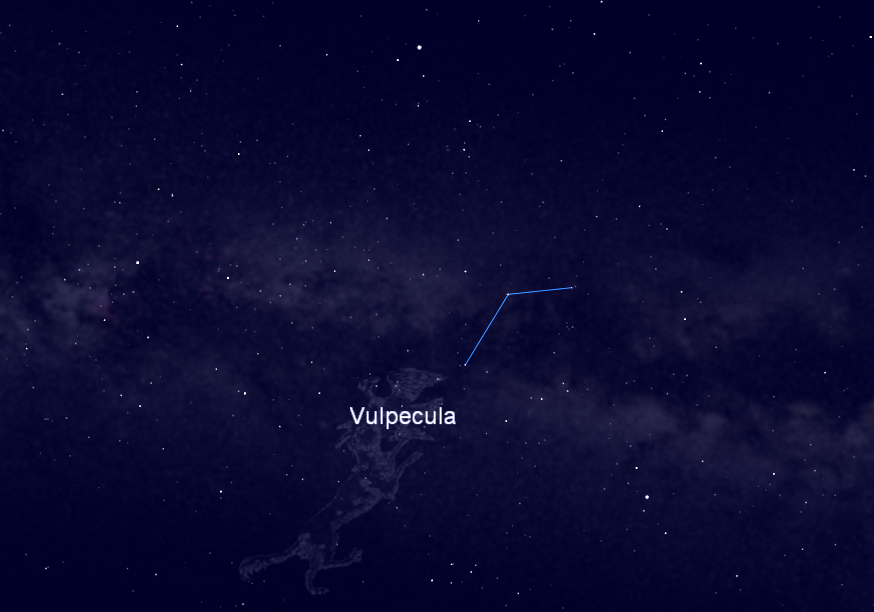
During the Perseid meteor shower this month I did some reminiscing on how, as a teenager, I used to watch this famous meteor display from my Aunt Irma and Uncle Ron’s house in then-rural Mahopac, New York, about 50 miles north of New York City.
In the early 1970s the northern suburbs of New York were amazingly dark — much darker then compared to now – and whenever I visited my Aunt and Uncle I always made sure to bring my binoculars or telescope with me, because their night skies provided a treasure-trove of celestial sights that I could never hope to see from my light-polluted home base in The Bronx.
And on one of those memorable midsummer nights, some 40 years ago, I stumbled across one of the most pleasing night sky sights for those using binoculars. It can be found this week nearly overhead in our late evening sky. With a bright moon currently out of the way, now is a good time to seek it out.
A coat hangar in space
Most amateur astronomers have heard of such beautiful open star clusters as the Pleiades, Hyades and the Beehive. But have you ever heard of the Coat Hanger?
Some evening this week, if you turn your binoculars east-southeast and look midway up from the horizon to the region of the sky roughly halfway between the bright stars Vega and Altair you will discover Brocchi's Cluster in the rather dim and nondescript constellation of Vulpecula, the Little Fox. [Amazing August Night Sky Photos]
During the 1920s, Dalmiro F. Brocchi, then a well-known chart maker for the American Association of Variable Star Observers, designed a star chart depicting the region of the sky around Vulpecula, revealing this cluster.
Get the Space.com Newsletter
Breaking space news, the latest updates on rocket launches, skywatching events and more!
For reasons that I have never been able to fathom, Brocchi’s Cluster is rarely mentioned in most popular astronomy books. Yet, it is the brightest of all the star clusters in this part of the sky! In Swedish astronomer Per Collinder’s star catalogue, which was drawn up in 1931, it is cluster No. 399, hence its “official designation as Collinder 399.
Those who have seen it have described it as a rather curious grouping of about a dozen tiny stars looking very much like an inverted coat hanger. In a clear, dark sky you might even perceive it with the naked eye as a fuzzy patch of light imbedded within the summer star clouds of the Milky Way. This is one object that is best suited for binoculars; even a small telescope will provide too much magnification and will cause the stars to appear too widely spaced apart.
Cosmic ladle or celestial seesaw?
Forty years ago while sweeping up and down the Milky Way with 7 x 35 binoculars, this delightful little cluster first hit my eyes. But actually, because the coat hanger figure appears upside down and a bit on a tilt, my original impression of it of it resembled some sort of a ladle (and since I was visiting my Aunt Irma when I made the discovery, I unofficially christened it "Irma’s Ladle").
Interestingly, what we are seeing in this pattern of stars is an illusion of perspective. This is not a true cluster at all, but rather just a chance alignment of stars that are placed at very different distances from our earthly vantage point.
However … Collinder 399 is really a proper coat hanger only for Southern Hemisphere observers, where it appears right side up. It is for this reason, that not everyone sees Collinder 399 as a coat hanger. In fact, I once heard of one gentleman out in California who independently discovered it and later inquired as to "Why is this fulcrum never shown on star charts? It is a beautiful sight."
And indeed, now that I’ve mentioned this allusion, it may cause many to see this cluster not as a coat hanger, but as a seesaw!
Joe Rao serves as an instructor and guest lecturer at New York's Hayden Planetarium. He writes about astronomy for The New York Times and other publications, and he is also an on-camera meteorologist for News 12 Westchester, New York.
Join our Space Forums to keep talking space on the latest missions, night sky and more! And if you have a news tip, correction or comment, let us know at: community@space.com.

Joe Rao is Space.com's skywatching columnist, as well as a veteran meteorologist and eclipse chaser who also serves as an instructor and guest lecturer at New York's Hayden Planetarium. He writes about astronomy for Natural History magazine, Sky & Telescope and other publications. Joe is an 8-time Emmy-nominated meteorologist who served the Putnam Valley region of New York for over 21 years. You can find him on Twitter and YouTube tracking lunar and solar eclipses, meteor showers and more. To find out Joe's latest project, visit him on Twitter.









